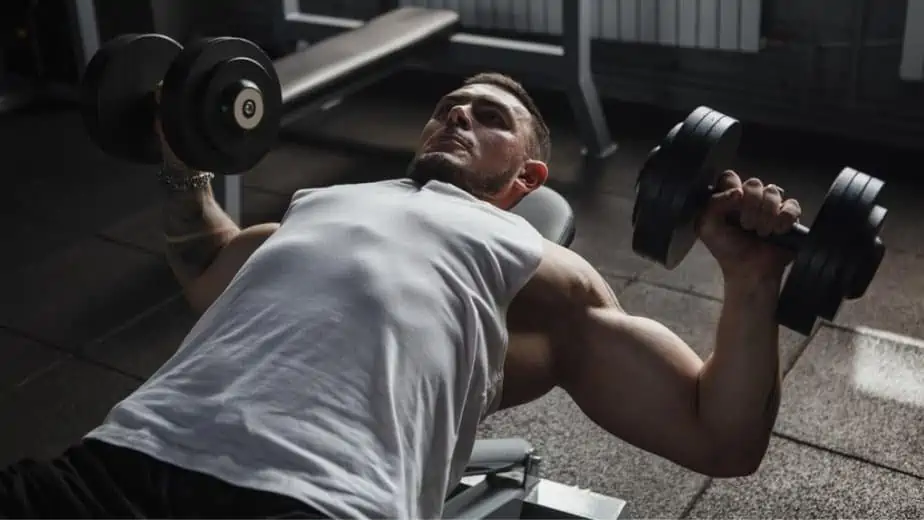Hypertrophy is the term used to describe the building of muscle, while strength training refers to increasing the strength of the muscle. The difference between them lies in how you train for each goal, the amount of weight, the sets, the reps, and the frequency at which you train per week.
When you train your muscles, there is a certain amount of tearing of the muscles that occur due to the amount of weight you use, the sets, and the reps of your training. Your rest time and period also play a huge role in achieving the goals you have set out.
You must know that when you want to increase the size of your muscles, you refer to hypertrophy training to achieve this. When you want to increase the strength of your muscle, you refer to strength training.
These should be your goals when you train either and this article will help you understand what each type of training entails, how you can make the most out of them and what their differences are.
What Is Hypertrophy Training?
Hypertrophy is the increase in muscle size and everything that has to do with muscle growth. There are two types of muscular hypertrophy being:
- Myofibrillar hypertrophy: the increase in the density and strength of the muscle due to the increase in myofibrils. Myofibrils are the chains that make up the muscle fibers allowing the muscles to contract.
- Sarcoplasmic hypertrophy: the increase in the size of the muscle due to the sarcoplasm (fluid) in the muscle, which is everything in the muscle other than the myofibrils.
Those who do hypertrophy training should be looking to build muscle. This requires your muscle fibers to undergo micro-tears under resistance (lifting weight) so that when the muscle fibers recover, more cells develop which causes an increase in the size of your muscles.
This type of training requires you to lift moderate weight at moderate reps while getting sufficient rest between sets to lift again, but not too much rest. The amount of weight should be between 70-80% of your one rep max with 3-5 sets. The reps should range between 6-12 while resting for 1-2 minutes between each set.
The frequency of training per week should allow for at least 24 hours of rest between training the same muscle group, for the muscles to recover fully and for you to fuel the muscles with the nutrients they need to grow.
Whether you are an athlete or fitness enthusiast, hypertrophy training should be part of the phases of your training. This is because when you want to get fitter, build muscle or lose fat, hypertrophy training can aid in achieving each goal.
The Importance of Hypertrophy for Your Fitness Goals
Athletes require hypertrophy training to build muscle, which in turn, increases their strength. Some athletes require the aesthetics that it brings to their careers, like bodybuilders and swimsuit athletes.
Hypertrophy training becomes an integral part of building muscle as that is the standard goal of it.
Weight and fat loss enthusiasts will also benefit from hypertrophy training because it will help with burning more calories. Training in general helps you burn more calories, but the building and maintaining of muscle helps you burn more calories as more energy is required in doing this than if you have less muscle.
How to Make the Most Out of Hypertrophy Training?
Focus on squeezing your muscles at the peak of the contraction when you are lifting the weight. You must maximize the time under tension when you are moving the weight as this maximizes the micro tears that occur in the muscle. This does not mean slow movement, but more controlled movement and really focusing on the muscle that you are training.
The most important nutrient that you require is protein to grow your muscles. You must consume at least 1.2 – 1.8 g of protein per kg of body weight or 0.5 – 0.8 g per pound of body weight to ensure that your muscles recover sufficiently and grow in size.
Protein is the building block of your muscles; this is why you require a sufficient amount of it for muscle growth. Your muscles undergo protein synthesis when you consume protein. This is where the building blocks of protein (amino acids) form bonds or links that help repair damaged muscle cells and maintain the muscle size as they recover from the micro-tears caused by weight lifting.
Your protein must come from lean sources like chicken breast, lean ground beef, and tuna for example, as these will ensure maximum protein and minimize other nutrients like carbohydrates and fat.
The Pros and Cons of Hypertrophy Training
- The Pros
– Less risk of injury as you are using moderately heavy weights.
– An increased chance of muscular definition and growth due to the volume at which you lift – better aesthetics.
– The high volume in terms of sets, reps, and training frequency involved in hypertrophy training requires more energy to do. This in turn helps you burn more calories, which is especially important for weight and fat loss.
– There is increased focus on individual muscles, so you can look to increase the size and strength of your weaker muscles through isolation exercises.
– You do not need to go to the gym to increase hypertrophy. Calisthenics is something you could try, but you will reach a limit in which you would need to increase the weight/resistance to build muscle.
- The Cons
– Your strength may take longer to increase than in strength training due to weight mass and activation of maximum strength.
– The Delayed Onset Muscle Soreness (DOMS) or pain in the muscle is greater due to the intensity and isolation of the muscle.
– The ease of adaptation in weight lifting may make it easier to not use the correct form of an exercise.
What is Strength Training?
Strength training is a type of training that involves strengthening the muscles by applying maximum force through muscle contraction. The muscles will not necessarily grow in size as rapidly as in Hypertrophy training, but there will be some growth. Here are some factors of strength training:
- Central nervous system (CNS): The control center of your movement, made up of your brain and spinal cord.
- Neural fatigue: Your body can only take so much volume of heavy lifting and at a point that is too intense, it will become tired and your performance will decrease. Take your rest days seriously for your CNS to recover from the strain it has been taking.
- Rate of force produced: The amount of force you can produce in each lift influences your overall strength. The stronger you get you look to do a progressive overload and improve. The speed at which you can lift also plays a huge role in improving your strength.
- Genetics and frame size: Your genetics and frame size will say a lot about how fast you can develop the skill of strength training. These factors will also influence how long it will take you to get stronger and how much force you can produce naturally without ever lifting heavy before. Mesomorphs, for example, are naturally more muscular than Endomorphs and Ectomorphs, which can induce more strength.
This type of training is ideal for someone that is looking to get stronger without necessarily worrying about how they will look aesthetically. It is required that you fuel your strength before you lift weights and afterward, to maintain it.
You do strength training by lifting heavy weights that are above 80% of your one-rep max weight. Perform every rep at your best because you are lifting to get stronger. Aim to do 1-5 reps for 3-5 sets resting 2-5 minutes between each set to achieve this.
Rest at least 24 hours between each session to get sufficient recovery of your muscles, your central nervous system and improve your performance at your next training session. You benefit well from strength training, whether you are looking to build muscle or lose fat.
The Importance of Strength Training for Your Fitness Goals
The everyday person will benefit from strength training because of how it affects their central nervous system. The heavier you start lifting, the greater your strength in carrying out heavy lifting in your daily job or at home.
The core purpose of strength training is to develop strength, but with any resistance on your muscles, you will build them. It should not be your go-to type of training if you want to build muscle though.
Strength training will help you burn calories because the heavier you lift, the more intense your workout becomes and the more energy you use. This will help you lose weight/fat if that is your goal. You must do more compound exercises to get the most out of your workouts and burn more calories.
You get athletes that require strength training to improve their strength in sports and improve the rate of force they produce in them. Some powerlifters lift heavy as a sport and they compete to be the strongest individuals.
How to Make the Most Out of Strength Training?
A proper warm-up is extremely important for strength training because you are looking to lift heavy weights with great force. You must warm up using a lightweight for the exercise that you are going to do. This way you will be mentally and physically prepared for the strain you are about to put your body under.
Compound exercises, which use more than one muscle group to complete a movement, should be your go-to. Squats, bench presses, and deadlifts, also known as the big three lifts, should be your foundational exercises in strength training. Those exercises alone activate all your muscle groups, whether they are major or minor in the movement.
Carbohydrates are your body’s first choice as an energy source. Consuming a sufficient amount is important for strength training. Consume at least 50% of your calorie intake from carbohydrates sources and products. This will improve the rate of force you produce, helping you feel stronger and lift heavier.
The carbohydrates serve as fuel, consume slow-burning carbs (low/medium GI), such as brown rice, whole-wheat bread and rolled oats, etc. They gradually increase your blood sugar levels for longer-lasting and efficient energy. You will feel more energized and stronger by the time you start lifting heavy weights.
The Pros and Cons of Strength Training
- The Pros
- The increased activation of the central nervous system and maximum weight lifting can improve your overall strength faster.
- You can train less with strength training and still be able to maintain your strength for longer. This is also due to the activation of your central nervous system.
- You do not need to go to the gym to do strength training and get stronger muscles. There are other exercises, such as yoga, calisthenics, and isometric training, which increase your strength.
- The Cons
- When you lift heavier, you increase your chances of injury because you put your body under increased strain. This is why it is important to warm up properly before strength training.
- Strength training requires more focus on precise form, because the heavier you lift, the more you tend to compensate with your form.
- Increased chances of neural fatigue than hypertrophy training. When you train with heavy weights which is the basis of strength training, your central nervous system is more activated which can increase the chances of it becoming fatigued, reducing your performance.
The Difference between Hypertrophy and Strength Training
There are differences between the two types of training, no matter how small, it is important to understand the differences so that you know how to achieve your goals, whether it is to build muscle, get stronger or even lose weight/fat.
Hypertrophy will get you closer to building muscle than strength, while strength training will get you closer to getting stronger rather than building muscle. The differences between the two types of training are the following and a table with specifics below this list:
The weights of the dumbbells and barbells you use are different with strength training generally requiring heavier weights to be effective.
- The sets are not that different, but hypertrophy can go up to 6 sets while strength training usually goes up to 5.
- The rep ranges are usually higher for hypertrophy vs strength training rep ranges.
- You are usually going as heavy as possible with minimal reps with strength training, while you can train until failure/fatigue with hypertrophy.
- Compound exercises are more beneficial when developing your strength while isolation exercises play a significant role in hypertrophy training.
- Each set requires your best performance for strength training so you may rest more between them. Hypertrophy training requires significant volume and tension in the muscle, so you must not rest for too long – over 2 minutes.
| Difference | Hypertrophy | Strength Training |
| Mass of weight | 70-80% of one rep max | >80% of one rep max |
| Sets | 3-6 sets | 3-5 sets |
| Rep Range | 6-12 reps | 1-5 reps |
| Rest between sets | 1-2 minutes | 2-5 minutes |
Hypertrophy vs Strength Training: How to Structure Your Schedule
Hypertrophy and strength training both have a role to play in your fitness journey. It is best to do your training in phases to get the most out of both types of training, whether you want to get stronger or build muscle.
You must train in 4-week phases, as this is when you will start seeing results for yourself. It is also a good benchmark to see what type of training works for you. Doing a cycle of up to 6 weeks of hypertrophy and then another 6-week cycle of strength training will help get the muscles bigger and stronger, maintaining as much size and strength as possible.
Try incorporating both of them in one training session. Starting with a compound exercise like a squat, bench press, or deadlift as a strength set, depending on what you are training, and then finishing off the rest of the session with hypertrophy training will help you get stronger and build muscle too.
Depending on your nutrition, they work whether you are looking to build muscle or lose fat.
Hypertrophy vs Strength Training Programs
No matter what your goals are, they require hard work, patience, and consistency. Something that makes these easier to achieve, especially consistency, is a program or routine that you can follow and use as a guide.
Set out a program that addresses your fitness goals. Your programs must be adaptable in the sense that you’re able to do them using different types of equipment, especially on days that you can’t make it to the gym.
You can get weight training programs for hypertrophy and strength training at Sport Fitness Advisor.
Summary
Understand what your training goals are, specifically concerning building muscle and/or getting stronger. You need to know what type of training is required and what it entails. When you want to build muscle size, it is best to do Hypertrophy training and for stronger muscles, it is best to do strength training. The amount of weight you use, the sets, reps, and frequency at which you train per week are huge factors
Both types of training are important for long-term fitness goals like weight/fat loss, muscle gain, and improving athletic performance. You burn calories with both. The intensity of them is the deciding factor of which is best for weight/fat loss. You build muscle with both types of training because your muscles do undergo micro-tears, more so with hypertrophy training. Whether you are doing hypertrophy or strength training, you can alter them to be sport-specific for improved performance.
They have pros and cons between them and you have to consider which ones are worth going ahead with. Hypertrophy is easier to adapt to in weight lifting, which may cause incorrect form while strength training can increase the chances of injury due to the heavy lifting. These are examples that you must before choosing the type of training towards your goals.
Structure your programs to see the results timeously, doing each type of training in 4-6 week phases/cycles or incorporating both in one session will help you reap the benefits of building the muscle and getting it stronger. We provide the best programs for beginners to athletes at Sport Fitness Advisor.



Oyisa Hackula was born in East London, South Africa where he currently resides working as an Industrial Engineer. He started strength and conditioning training in 2014 for high school rugby. He went on to play professional rugby from 2016 until 2018, but his passion for training continued while he still plays amateur rugby. He started with a lack of knowledge in health and fitness besides what he heard from his rugby peers, coaches and society. This had lead to him developing a physique that wasn’t efficient or effective for his rugby playing in 2014. He decided to dive deeper into it through research, having one of his best rugby seasons in 2015. Oyisa is currently an HFPA Qualified Personal Trainer (REPSSA) specializing in strength training, fat loss and supplementation. He has ambitions of reaching the world in showing how strength training, muscle building and fat loss can be made simple, but not easy and this is what he writes about.










